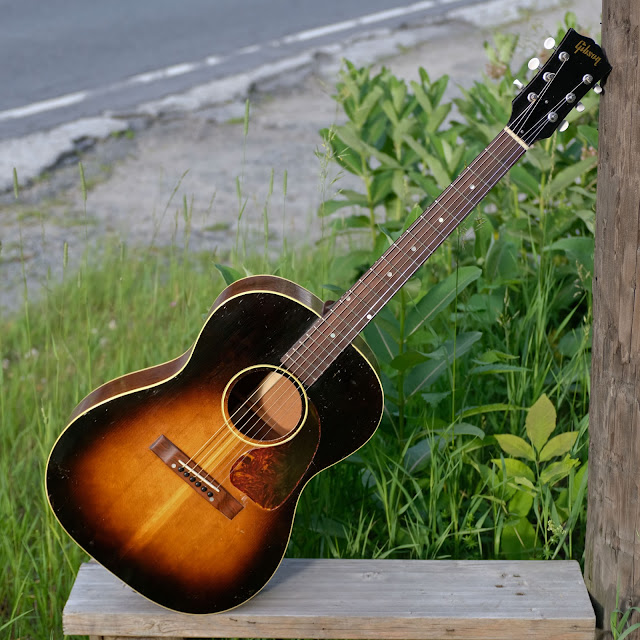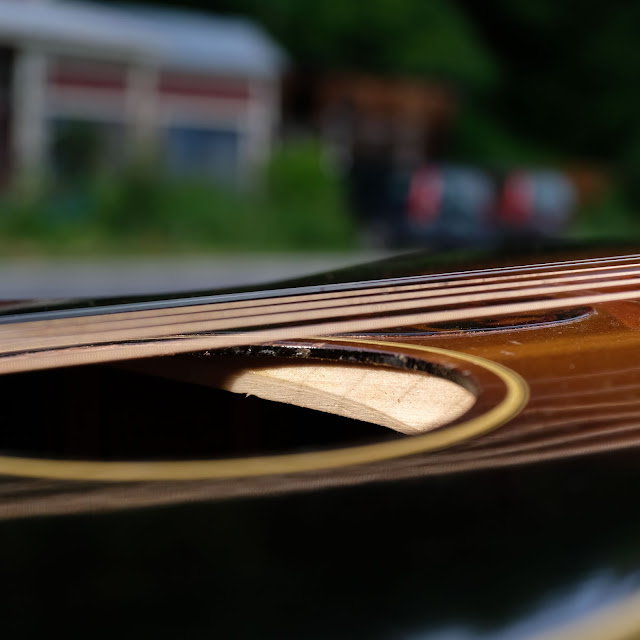1951 Gibson LG-1 (X-Braced Conversion) Flattop Guitar
How about that, folks? This is an LG-2 on the cheap-er, basically. It sounds every bit as tasty as the '57 LG-2 that's in the shop, though probably because of the earlier build date it's a bit warmer and a little less punchy.
While this began life as a humble, ladder-braced LG-1 with that woody, bluesbox tone, it was converted to x-bracing by Moonlight Luthiers in July of 2017. At the same time it appears the bridge was replaced and the board was planed and refretted. The back, sides, and neck have all been refinished, too, though the headstock and guitar top seem to just be lightly-oversprayed on the original finish. A center-seam liner for the back seems to have been added as well and there are some reinforcement strips added to the waist-area of the sides.
The new owner/consignor bought it early this year and after it'd settled in its new environment a few days, a couple of tight-but-long cross-grain hairline cracks snapped into existence on the back of the guitar. It also wasn't playing right and so was brought in to get those cracks cleated and other setup issues ironed-out before sale.
My work included cleating said cracks (which was difficult because they're almost invisible -- especially inside the guitar), a fret level/dress, depth increase to the saddle slot, a new bone saddle, re-stain of the bridge so its color would be more natural, and a good setup. It plays perfectly, the trussrod functions and the neck is straight, and it's strung with 54w-12 strings. Its voice is warm, balanced, has a ton of mids, and a good, punchy attack.
Specs are: 24 3/4" scale, 1 11/16" nut width, 1 7/16" string spacing at the nut, 2 3/16" spacing at the bridge, 14 1/4" lower bout, 11" upper bout, and 4 3/8" side depth at the endblock. The neck has a 12" radius to the board and a mild-to-medium C-shaped back profile (standard vintage Gibson).
Woods are: solid spruce top (rebraced), solid mahogany back, sides, and neck, rosewood fretboard and bridge.
The truss cover looks original but the screws are not. The nut is new and seems to be Tusq. The tuners are StewMac relic '40s Kluson-style repros.
I have to admit that it's nice to have medium/large frets on this. I'm used to the narrow wire on ones from this period.
The original pickguard's looking good, huh?
One thing to note is that the bridge is glued slightly askew. You won't notice it at a glance. I imagine this was done so the saddle would be compensated correctly.
So -- the Moonlight fellas knocked the neck angle back enough that the new saddle looks like a bluegrasser's wet dream of what a saddle should look like -- super-tall and with a hard string-angle behind it. Because of the height I had to dig the saddle-slot a lot deeper and make a new, taller one to keep it from leaning under the string pressure.
Now it's a bit happier. It still leans just a hair, but no more than the average acoustic saddle. The original one was practically falling over when it came in.
Here's one of those cracks -- only visible because I've got the light just-so on it. These go across the grain and are very tight. It was quite the job to figure-out where to put my cleats on the inside. I had to really wick glue into it like mad and rub it in for little beads to form on the inside so I could find it.
Here's the second, shorter one on the bass side.
Please excuse my puddles of extra watered-down-glue around the (big) cleats. I had to reposition them a lot until they were running in a line down the cracks and then wipe-off the excess.
A good hard case comes with it.
























Comments
It is true that Gibs in general feel a bit stiffer and more stout in the late '50s which seems to have made most of them barkier and then that's reversed in the early '60s when the bracing and tops get lighter (except for student models) and they all sound a lot warmer but less focused. That statement is VERY generalized.